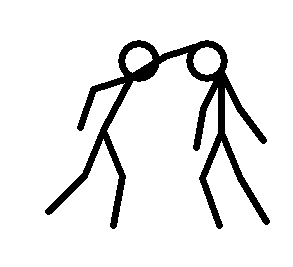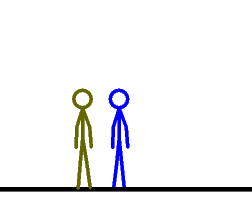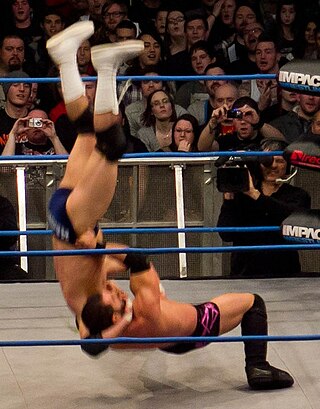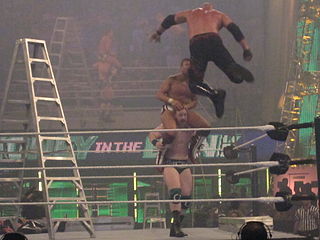Professional wrestling throws are the application of professional wrestling techniques that involve lifting the opponent up and throwing or slamming them down. They are sometimes also called "power" maneuvers, as they are meant to emphasize a wrestler's strength. Many of these moves are used as finishers by various wrestlers, who refer to them by several different names that reflect their gimmick. Moves are listed under general categories whenever possible.
Professional wrestling holds include a number of set moves and pins used by performers to immobilize their opponents or lead to a submission. This article covers the various pins, stretches and transition holds used in the ring. Some wrestlers use these holds as their finishing maneuvers, often nicknaming them to reflect their character or persona. Moves are listed under general categories whenever possible.
A suplex is an offensive move used in sport wrestling as well as amateur wrestling and professional wrestling. It is a throw that involves lifting the opponents and bridging or rolling to slam them on their backs.
Aerial techniques, also known as "high-flying moves" are maneuvers in professional wrestling using the ring's posts and ropes as aids, in many cases to demonstrate the speed and agility of smaller, nimble and acrobatically inclined wrestlers preferring this style instead of throwing or locking the opponent. Due to injuries caused by these high-risk moves, some promotions have banned the use of some of them. The next list of maneuvers was made under general categories whenever possible.
Strikes can be offensive moves in professional wrestling, that can sometimes be used to set up an opponent for a hold or for a throw. There are a wide variety of strikes in pro wrestling, and many are known by several different names. Professional wrestlers frequently give their finishers new names. Occasionally, these names become popular and are used regardless of the wrestler performing the technique.

In professional wrestling, a pin is a move where a wrestler holds an opponent's shoulders to the mat. A pinfall is a common victory condition, where the attacker pins an opponent and the referee makes a three count before the opponent gets released from the pin.
In professional wrestling double-team maneuvers are executed by multiple wrestlers instead of one and typically are used by tag teams in tag team matches. Many of these maneuvers are combination of two throws, or submission holds. Most moves are known by the names that professional wrestlers give their "finishing move" names. Occasionally, these names become popular and are used regardless of the wrestler performing the technique. Moves are listed under general categories whenever possible.

A dropkick is an attacking maneuver in professional wrestling. It is defined as an attack where the wrestler jumps up and kicks the opponent with the soles of both feet; this sees the wrestler twist as they jump so that when the feet connect with the opponent one foot is raised higher than the other and the wrestler falls back to the mat on their side, or front. This is commonly employed by light and nimble wrestlers who can take advantage of their agility, and is often executed on a charging opponent, while charging at an opponent, or a combination of the two.

A piledriver is a professional wrestling driver move in which the wrestler grabs their opponent, turns them upside-down, and drops into a sitting or kneeling position, driving the opponent head-first into the mat. The technique is said to have been innovated by Wild Bill Longson.

A powerbomb is a professional wrestling throw in which an opponent is lifted and then slammed back-first down to the mat. The standard powerbomb sees an opponent first placed in a standing headscissors position. The opponent is then lifted on the wrestler's shoulders and slammed down back-first to the mat. A prawn hold is commonly used for a pinning powerbomb.

In professional wrestling a DDT is any move in which the wrestler has the opponent in a front facelock/inverted headlock and falls down / backwards to drive the opponent's head into the mat. The classic DDT is performed by putting the opponent in a front facelock and falling backwards so that the opponent is forced to dive forward onto their head. Although widely credited as an invention of Jake Roberts, who gave the DDT its famous name, the earliest known practitioner of the move was Mexican wrestler Black Gordman, who frequently performed it during the 1970s before Roberts popularized it nationwide.
In professional wrestling, a neckbreaker is any throw or slam that focuses its attack on the opponent's neck. One type of neckbreaker involves the wrestler slamming an opponent's neck against a part of the wrestler's body, usually the knee, head or shoulder. The other type of neckbreaker is a slam technique in which the wrestler throws an opponent to the ground by twisting the opponent's neck. This also refers to a "back head slam" where a wrestler drops to the mat while holding an opponent by their neck.

A brainbuster is a professional wrestling throw in which a wrestler puts the opponent in a front facelock, hooks their pants or thigh, and lifts them up as if they were executing a vertical suplex. The wrestler then falls onto their back so that the opponent lands on their head while remaining vertical. This move is a version of the DDT. It was innovated by Killer Karl Kox. In Japanese puroresu, the term "brainbuster" refers to a regular vertical suplex, while the move elsewhere known as a brainbuster is referred to as a "vertical drop brainbuster".

A leg drop or legdrop refers to an attack used in professional wrestling in which an attacking wrestler will jump and land his leg across a fallen opponent's chest, throat, face or head or in some cases, the groin/lower-abdominal area.
A facebuster, also known as a faceplant, is generally a takedown move in professional wrestling in which an attacking wrestler forces their opponent down to the mat face-first without involving a headlock or facelock. A standard facebuster, also known as a jumping facebuster, involves the wrestler grabbing hold of the opponent's head/hair and dropping down to their knees, forcing the opponent's face into the mat.
A Powerslam or simply Slam is a professional wrestling body slam move in which the wrestler performing the slam falls face-down on top of the opponent. The use of the term "powerslam" usually refers to the front powerslam or the scoop powerslam.

In professional wrestling, a cutter is a 3⁄4 facelockbulldog maneuver. This move sees an attacking wrestler first apply a 3⁄4 facelock before falling backwards to force the opponent face-first to the mat below.

A stunner is a professional wrestling move, also a common term in professional wrestling referring to the ¾ facelock jawbreaker maneuver. The innovator of the move has been disputed, as both Mikey Whipwreck and Michael P.S. Hayes have both claimed to be behind the origin of the move. The move was named for Stone Cold Steve Austin's Stone Cold Stunner finisher, a finisher suggested to him by Hayes. It involves an attacking wrestler applying a three-quarter facelock before falling to a seated position and forcing the opponent's jaw to drop down on the shoulder of the attacking wrestler. The free hand is sometimes used to hold the top of the head.

Doomsday device is a term used in professional wrestling to reference a tandem move in which one wrestler hoists the opponent on their shoulders so that they are facing in the same direction in what is known as the electric chair position, while another wrestler climbs the ring post to the top turnbuckle and delivers a flying attack on the opponent.

Super J-Cup: 1st Stage was the first Super J-Cup professional wrestling tournament hosted by New Japan Pro-Wrestling (NJPW). The event took place on April 16, 1994, at Sumo Hall in Tokyo, Japan. The tournament featured fourteen junior heavyweight wrestlers and was created by Jushin Thunder Liger and was the first NJPW event to feature only junior heavyweight wrestlers. The event received critical acclaim and commercial success, leading to Japanese promotions hosting more editions of the tournament, leading to the event being renamed the Super J-Cup: 1st Stage in later years.

















